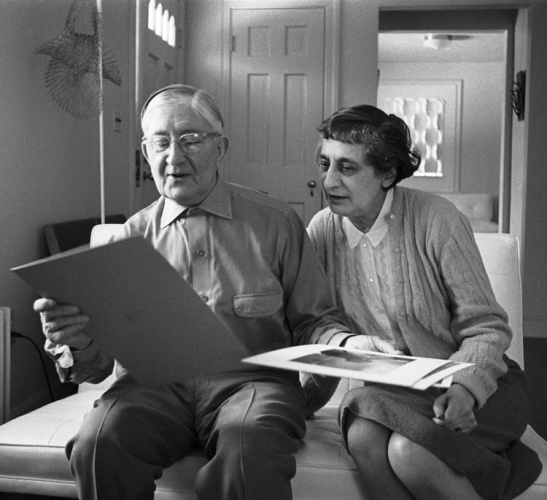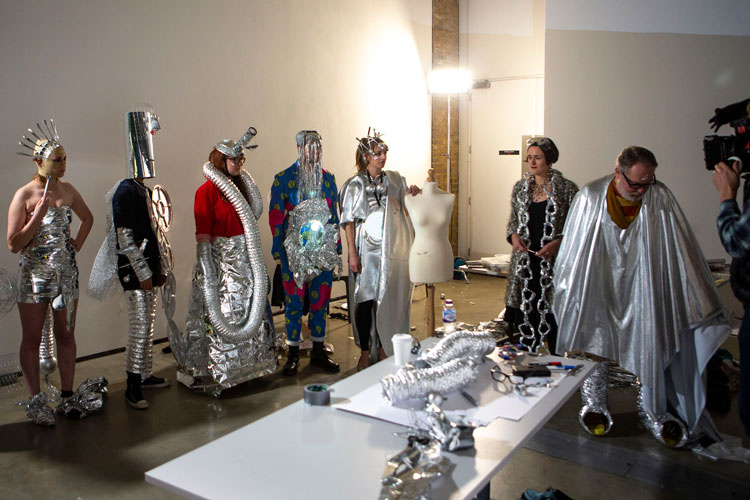From Bauhaus to Benidorm: exploring the new BBC design season
We talk to the creators of the new BBC series, which brings viewers stories from Bauhaus, a revealing hour with Dieter Rams and Vic Reeves in silver spandex.

estate
For Bauhaus’ 100th anniversary, BBC Arts faced a challenge: how to tell a fresh story about such a well-known subject?
Janet Lee, the executive producer for the three Bauhaus episodes, says: “You don’t want to let the Bauhaus down.”
The aim, Lee says, was to create a show that was “not in any way a conventional historical documentary”.
The new series from BBC Arts and BBC Four — which comprises six episodes in total — looks at design with a focus on the human faces behind the movements.
Three episodes centre on the German design movement. Bauhaus 100 recounts the history of the movement, Bauhaus Rules makes six arts students live and work according to Bauhaus principles.
Anni Albers: A Life In Thread uncovers the story of the school’s textile designer, who was previously best known simply as Josef Albers’ husband.
Two more episode are designer-focused; Rams examines Dieter Rams’ influence with interviews with the German product designer, while an episode on Peter Rice examines the engineer’s global influence, from Sydney to Paris.
In the sixth episode, broadcaster Jonathan Meades explores Franco’s influence on Spanish architecture, not in the state buildings the dictator commissioned but in more unexpected places: the tourist tower blocks of Benidorm.
“Human elements”

The thread through all of these was to find the “human elements”.
“We are always looks for the human stories,” Lee says.
One of these highlights, is a story from an episode about Anni Albers, a textile designer whose work was celebrated by the Tate Modern with a retrospective last year.
When Albers, the daughter of bourgeoise parents who did not expect her to go to art school, brought home Josef Albers for the first time — an “older, weird-looking, emaciated” man — she had thought her parents would not like him, says Lee.
But within ten minutes, her mother had come around to him.
The Anni Albers episode is also an antidote to some of the contemporary prejudice she encountered. Water Gropius, the Bauhaus founder, was worried that having too many female designers would make his movement seem less serious.
Lee says that one of the intentions of the series was to “take a look at the movement again, through 21st century eyes”.

That doesn’t mean there is a complete departure from the design movement, however. The director, Mat Whitecross, has created a documentary that channels the Bauhaus movement, Lee says.
The film has a “punk aesthetic” because Whitecross felt that the Bauhaus “were punks who wanted to change everything”, Lee says.
“It’s cut very fast, and packs so much information in,” she says. “It’s form follows function.”
“We’ve not gone totally Love Island”
Bauhaus Rules sees six Central St Martins graduates subjected to the Bauhaus school rules, as set out by its influential member and colour theorist, Johannes Itten.
The show is overseen by comedian Jim Moir, better known at Vic Reeves, who himself attended a part-time course at a local art college in the 1980s.
“We’ve not gone totally Love Island,” Lee says. “What we do is recreate the Bauhaus education and teachings by the masters.”
Some of the rules that the students are subjected to include breathing exercises and a diet of “garlic mush”, which was thought to have spiritual benefits.
Throughout this immersive education, the students are given interdisciplinary tasks.
In a painting class, artist David Bachelor makes them create designs according to Kandinsky’s work, with red, blue and yellow colours and only three shapes: triangles, circles, squares.
Graphic designer Neville Brody teaches the students some of the Bauhaus’ iconic typography.
At the end of the episode, they have a metal dance party, in the tradition of the Bauhaus celebrations.
Holly Faulton, a London-based fashion designer, leads the students through the party planning, in an attempt to show that the sometimes “austere”-seeming school was also a “playground for creativity”.
The students have to decorate a room and create party outfits, just as Bauhaus designer, Oskar Schlemmer did.
Reeves himself enters into the spirit of this “sensory experience”, dressing as — according to the comedian — a “metallic cyclops horse”.
“As elegant and unassuming as its subject”

Form follows function — the Bauhaus principle that an object’s design ought to relate to its intended function — is apt for other episodes in the series.
Mark Bell, the commissioning editor for BBC Arts, says that the documentary on Dieter Rams is “a appreciation, as elegant and unassuming as its subject”. It is shot and directed to an original score by Brian Eno.
The episode follows the 87-year-old German designer, whose work at Braun looms large over the design industry.
As well as exploring Rams’ principles of good design, the episode gives viewers a rare glimpse of his private life at home with his wife, Ingeborg.

A candid sequence sees Rams criticising “unnecessary” designs, with a particular focus on Frank Gehry.
Bell’s favourite moment is when the “venerable” Rams puts on a jazz record on an old Braun turntable in his house and starts dancing around in his sunglasses.
This intimate moment is reminiscent of Rams’ outlook. At one point, Rams tells the viewers that “every design has a story,” even the ones he doesn’t like.
An “appetite” for design programming

Recently, design programming has experienced a revival.
Lamia Dabboussey, the acting director of BBC Arts, says that it’s “always important” to look at design but that it’s “often overlooked because it does its job so well it can often feel invisible”.
“We really just want to get people talking and thinking about design and to start noticing it all around them,” she says.
It’s not just the BBC that has focused on design recently. Netflix’s 2017 show, Abstract: The Art of Design followed creatives in different fields of design, such as Bjarke Ingels for architecture and Paula Scher for graphic design.
“There’s definitely an appetite for a subject as rich as design,” Daboussey says, “it’s full of visual appeal, inspirational personal stories and great characters.”
There is also an educational slant to BBC’s design programming.
“It opens up the world of possibility for those who might want to pursue a career or ever further a hobby in design.”
The first two episodes in the series air August 21 on BBC Four at 9pm.





What was left to say here was that the Rams episode, “shot and directed to an original score by Brian Eno”, was in fact directed by Gary Hustwit – the brilliant director from the design trilogy Helvetica, Objectified, and Urbanized. The film was crowdfunded and released in 2018 as a 74 minutes documentary feature film. In Hustwit’s films the score had always played a leading role, and is his merit the invitation to Brian Eno to contribute with his acclaimed expertise to the film.